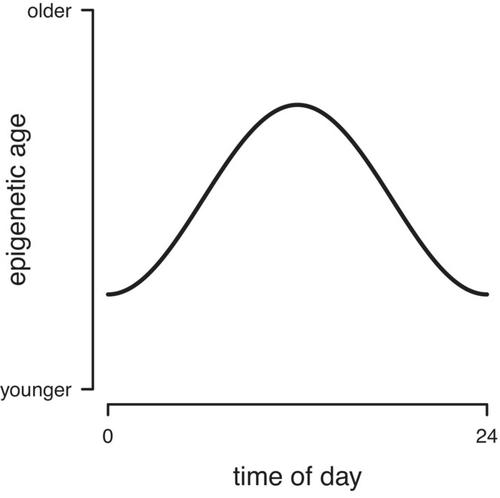当前位置:
X-MOL 学术
›
Aging Cell
›
论文详情
Our official English website, www.x-mol.net, welcomes your feedback! (Note: you will need to create a separate account there.)
Epigenetic age oscillates during the day
Aging Cell ( IF 7.8 ) Pub Date : 2024-04-18 , DOI: 10.1111/acel.14170 Karolis Koncevičius 1 , Akhil Nair 1, 2 , Aušrinė Šveikauskaitė 1 , Agnė Šeštokaitė 3 , Auksė Kazlauskaitė 1 , Audrius Dulskas 4, 5 , Artūras Petronis 1, 2
Aging Cell ( IF 7.8 ) Pub Date : 2024-04-18 , DOI: 10.1111/acel.14170 Karolis Koncevičius 1 , Akhil Nair 1, 2 , Aušrinė Šveikauskaitė 1 , Agnė Šeštokaitė 3 , Auksė Kazlauskaitė 1 , Audrius Dulskas 4, 5 , Artūras Petronis 1, 2
Affiliation

|
Since their introduction, epigenetic clocks have been extensively used in aging, human disease, and rejuvenation studies. In this article, we report an intriguing pattern: epigenetic age predictions display a 24-h periodicity. We tested a circadian blood sample collection using 17 epigenetic clocks addressing different aspects of aging. Thirteen clocks exhibited significant oscillations with the youngest and oldest age estimates around midnight and noon, respectively. In addition, daily oscillations were consistent with the changes of epigenetic age across different times of day observed in an independant populational dataset. While these oscillations can in part be attributed to variations in white blood cell type composition, cell count correction methods might not fully resolve the issue. Furthermore, some epigenetic clocks exhibited 24-h periodicity even in the purified fraction of neutrophils pointing at plausible contributions of intracellular epigenomic oscillations. Evidence for circadian variation in epigenetic clocks emphasizes the importance of the time-of-day for obtaining accurate estimates of epigenetic age.
中文翻译:

表观遗传年龄在白天波动
自推出以来,表观遗传时钟已广泛应用于衰老、人类疾病和复兴研究。在本文中,我们报告了一个有趣的模式:表观遗传年龄预测显示 24 小时周期性。我们使用 17 个针对衰老不同方面的表观遗传时钟测试了昼夜节律血液样本采集。十三个时钟分别在午夜和中午左右表现出显着的振荡,其中最年轻和最古老的年龄估计值分别是。此外,每日振荡与在独立群体数据集中观察到的一天中不同时间的表观遗传年龄的变化一致。虽然这些波动部分归因于白细胞类型组成的变化,但细胞计数校正方法可能无法完全解决该问题。此外,一些表观遗传时钟甚至在中性粒细胞的纯化部分中也表现出 24 小时周期性,这表明细胞内表观基因组振荡的可能贡献。表观遗传时钟昼夜节律变化的证据强调了一天中的时间对于获得表观遗传年龄的准确估计的重要性。
更新日期:2024-04-18
中文翻译:

表观遗传年龄在白天波动
自推出以来,表观遗传时钟已广泛应用于衰老、人类疾病和复兴研究。在本文中,我们报告了一个有趣的模式:表观遗传年龄预测显示 24 小时周期性。我们使用 17 个针对衰老不同方面的表观遗传时钟测试了昼夜节律血液样本采集。十三个时钟分别在午夜和中午左右表现出显着的振荡,其中最年轻和最古老的年龄估计值分别是。此外,每日振荡与在独立群体数据集中观察到的一天中不同时间的表观遗传年龄的变化一致。虽然这些波动部分归因于白细胞类型组成的变化,但细胞计数校正方法可能无法完全解决该问题。此外,一些表观遗传时钟甚至在中性粒细胞的纯化部分中也表现出 24 小时周期性,这表明细胞内表观基因组振荡的可能贡献。表观遗传时钟昼夜节律变化的证据强调了一天中的时间对于获得表观遗传年龄的准确估计的重要性。



























 京公网安备 11010802027423号
京公网安备 11010802027423号